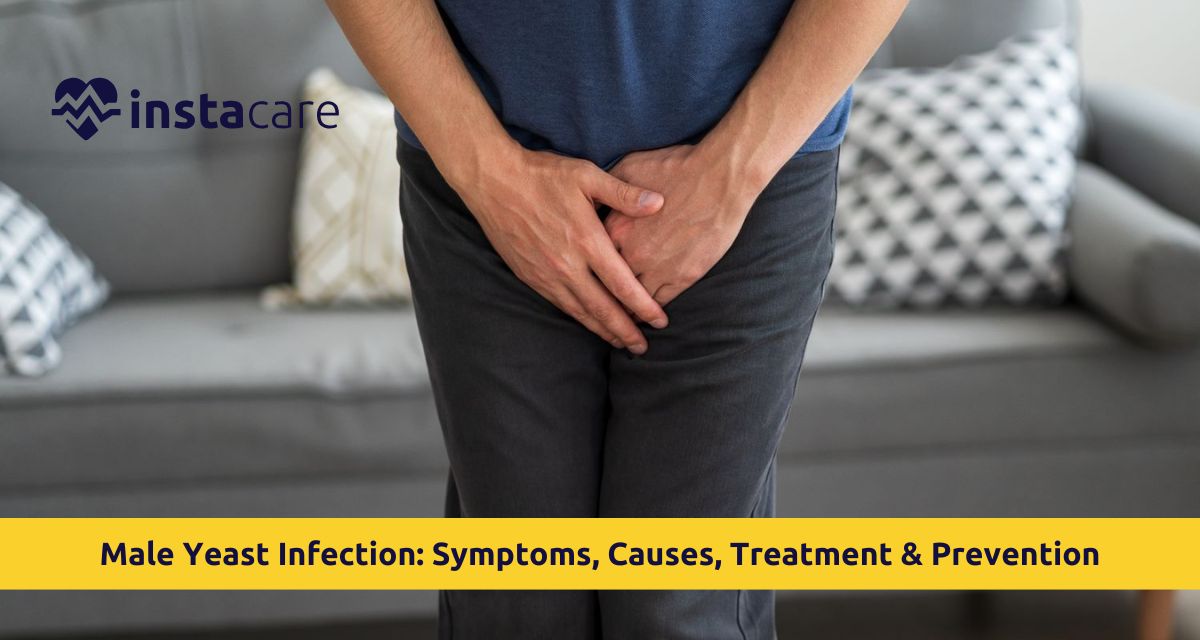What is a Yeast Infection?
Yeast infection is an overgrowth of Candida, a form of yeast that exists on the body in small amounts. When the balance between fungus and bacteria is interrupted, Candida will proliferate and result in pain and inflammation.
It is here that it is also most likely to manifest as a penile yeast infection, or thrush in men, or balanitis if the infection is the glans (tip) of the penis. The infection will extend to the foreskin and other skin.
Although Candida infections are typically cultivated in moist regions of the body, beneath the foreskin, yeast infection male groin, or skin fold, they could also have some potential to be related to causes that are systemic in nature such as
high blood sugar levels or immunosuppressive drugs.
Male Yeast Infection Causes
Some general yeast infection in men causes include:
- Poor hygiene: Inadequate washing of the penis, particularly underneath the foreskin, will clog pores and allow yeast to thrive.
- Use of antibiotics: Broad-spectrum antibiotics kill good bacteria that help maintain a balance of Candida. This results in yeast infection from antibiotics.
- Diabetes: Blood sugar swings create a perfect setup for yeast growth.
- Immune compromise: HIV/AIDS, corticosteroids, and other disease or drug that inhibits immunity predisposes to infection.
- Tight underpants and synthetic material: Tight underpants and synthetic material induce sweat and heat buildup and stimulate infections.
- Sex: Yeast infection is spread through sex, particularly if a partner is infected.
- Men who are circumcised: Foreskin becomes more moist and yeast-infected unless washed.
Symptoms of Male Yeast Infection
You might be having some or all of the symptoms of yeast infection in male if you are infected by yeast in the man:
- Redness and swelling of the penis
- Itching and burning, particularly on and around the glans and foreskin tip
- Thick, lumpy white discharge
- Pain or burning during peeing or sex
- White patches on the glans
- Off or bitter smell
In other instances, foreskin tightness cannot be retracted, a situation referred to as phimosis, caused by redness and swelling.
While some of the signs will resemble those of STDs, all of the yeast infections will be sensitive to antifungals. But if you're experiencing recurring or extreme symptoms, it is always advisable to seek the services of a healthcare provider for diagnosis.
Treatments of Male Yeast Infection
There are several effective treatment for male yeast infection. Some are available over the counter, while others need a prescription from a doctor:
- Topical antifungals: Topical creams of clotrimazole, miconazole, or ketoconazole are applied directly to the penis and around it for 7–14 days.
- Oral antifungals: Fluconazole is an oral antifungal with a single dose in which the infection would instantly be killed if there is an aggressive or a chronic infection.
- Male yeast infection home remedies: In minor male yeast infection home remedies can be practiced through such actions as applying coconut oil or plain, unsweetened yogurt to the infected region. These are applied along with, and not in place of, antifungals.
- Good hygiene: Wash the area in warm water with mild soap, and dry it thoroughly prior to wearing underwear as part of treatment.
- Prevent irritants: While being treated, avoid using strong soap, shower gel, or perfumes on the groin area.
Always follow the antifungals as instructed and complete the course even if the condition resolves earlier.
What are the Prevention Tips for Male Yeast Infection?
It is also important to look at how to prevent yeast infection in men. Follow the following methods:
- Keep the genital area dry and clean: Shower every day and dry yourself thoroughly, especially in the foreskin region.
- Do not wear tight or wet clothing: Wear loose clothing such as cotton boxers and change the clothes immediately after working out.
- Practice safe sex: The use of condoms may reduce transmission of Candida between two partners in either direction.
- Manage diabetes well: Management of blood sugar can reduce yeast overgrowth to a large extent.
- Avoid taking unnecessary antibiotics: Use antibiotics only when prescribed and complete the entire course of treatment advised.
- Develop immunity: Eat properly, exercise regularly, and get plenty of rest to build your immunity.
Conclusion
A man's yeast infection will be awkward, but not uncommon and highly treatable. Knowing how to recognize male yeast infection signs, why male yeast infections happen, and the application of antifungal when you initially experience signs will have you in business soon and save you further suffering.
Prevention is also the best medicine, dry it out and clean it up, wear loose underwear, and steer clear of hard soap and products that kill the natural balance of the skin. And in addition, the control of associated diseases such as diabetes can limit the likelihood of recurrent infection. In the case where the infections fail to heal or continue to occur even after appropriate treatment and care, it is recommended to consult a health practitioner to ensure to look for other infections or diseases.
Please book an appointment with the
best Urologist in Lahore, Karachi, Islamabad, and all major cities of Pakistan through
InstaCare, or call our helpline at 03171777509 to find a verified doctor for your disease.

